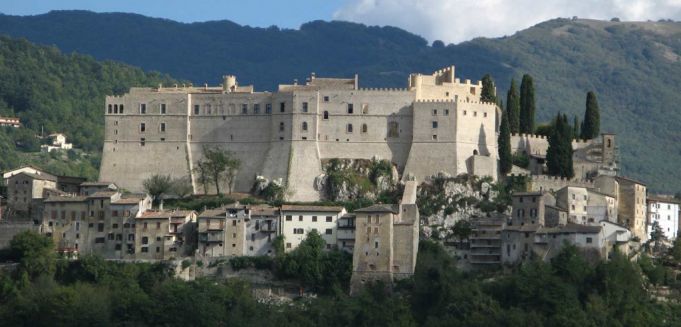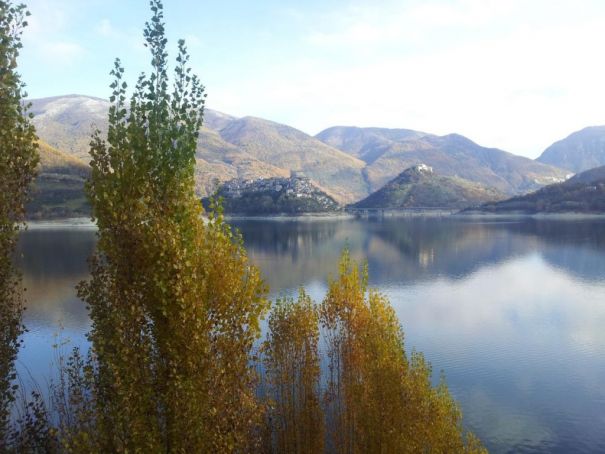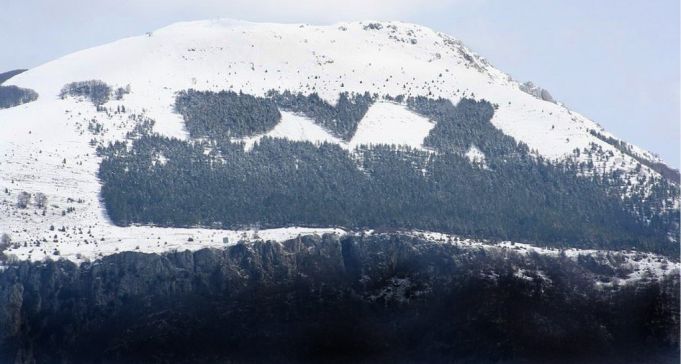The Turano Valley has been of strategic interest over the centuries.
The impressive fortress of Rocca Sinibalda overlooks and protects the tiny mediaeval village at its foot, dominating the meandering lower reaches of the Turano valley just east of the Via Salaria as it approaches Rieti. As such it features strongly in the contrasting elements that have transformed this rural valley over the centuries.
Indeed the word metamorphoses not only reflects the inspiration of Ovid’s Metamorphoses and is the name given to the 16th-century cycle of frescoes in the castle, but also accurately describes some of the changes which have taken place in the valley.
Strategic importance of the Turano valley
The strategic importance of the Turano valley became evident over time as the result of various foreign invasions. By the end of the eighth century AD, the Lombards had spread from south of the Danube into central Italy and as far as Sabina. Afraid for the safety of Rome, Pope Leo III appealed to the Frankish King Charlemagne to come to his defence. This led not only to the defeat of the Lombards but also to the establishment of the Holy Roman Empire and the crowning of Charlemagne in Rome on Christmas Day, 800.
Among his other tasks, Charlemagne personally undertook the protection of the fifth-century abbey at Farfa, which was growing in wealth and was to become one of the most important in Europe.
Also read: Greccio - home of the world's first Nativity scene
Donations of property and precious objects to abbeys such as Farfa were seen at this time as a means of ensuring salvation of the donor’s soul, “pro remedio anima”, and Farfa became not only rich and powerful but also the object of envy. In consequence, Sabina together with parts of southern Italy suffered more than 30 years of occupation by Saracens from North Africa, ending with their defeat at the battle of Garigliano in August of 916. As defence against these invasions, important abbeys such as Farfa saw a period of castle-building in the high Middle Ages.
Mediaeval fortifications in Sabina
Sabina provides many good examples of this period of encastellamento, when defensive walls, towers and castles were built. The fortress at Rocca Sinibalda, owned by the abbots of Farfa until 1118, was probably constructed about this time. With the decline of Carolingian power it then passed through the hands of various important local families such as the Romania and Mareri in succeeding centuries.

Pope Clement VII confiscated the part of the castle held by Muzio Mareri in 1526 and gave it early the following year to Cardinal Alessandro Cesarini, who then set about acquiring the remaining portion of the castle and its feudal lands.
Also read: Rome's ancient aqueducts
After the devastating sack of Rome in May 1527, Cesarini – who was one of the cardinals held hostage by the mutinous troops of Charles V – decided to maintain a bolt-hole in the countryside and set about transforming his fortress into a more suitable residence.
Strongholds become palaces
The resulting palatial castle of Rocca Sinibalda is a prime example not only of the new wave of rebuilding which transformed strongholds into palaces, but of the metamorphoses in architecture and frescoes typical of the new 16th-century Mannerist movement. Work at the castle started in 1532, with the architect Baldassarre Peruzzi chosen to transform the existing fortress. He did so by extending it into a form described at the time as zoomorphic, resembling a severe-looking eagle with outspread wings perched on the rocky ridge of Rocca Sinibalda.
Also read: Visiting the Abbey of Chiaravalle
The Mannerist work of that era in Italy (1520-80) was a reaction to the preceding classical Renaissance art in that it rejected naturalism in favour of elongated shapes, a distortion of perspective and unusual or thought-provoking composition. Although the transformation of other fortresses such as Villa Farnese at Caprarola during the same period was also carried out using a Mannerist approach (here the architect was Giacomo Barozzi da Vignola, who also designed Via Giulia in Rome), that of Rocca Sinibalda is known as "the castle of metamorphoses".
Also read: Best museums in Rome
Registered as a national monument in 1928, the castle has recently undergone a seven-year restoration and now houses sculpture and art collections that contrast with and yet complement the artwork of the 16th century.*

Mussolini's public works change the valley
In another metamorphosis of the valley, the natural course of the Turano river was rudely interrupted in 1939 when Mussolini's government erected a dam at Posticciola, a frazione of Rocca Sinibalda, to help feed water to the hydro-electric plant at Cotilia powering the new steelworks at Terni. The river above the dam became a lake and a long road bridge was built over its upper stretches to link the villages of Castel di Tora and Antuni to Colle di Tora, Rocca Sinibalda and the lower river valley.
Also read: San Gimignano - A town of fine towers in Tuscany
Another of the public works in the area undertaken by the Fascist government was the establishment of a school for the Corpo Forestale dello Stato in nearby Cittaducale. The equivalent of the British Forestry Commission, this organisation was responsible for managing woodlands and wildlife all over Italy (it is currently being dismantled and its staff absorbed into other forces such as the Carabinieri). In 1939, to recall the role Il Duce played in its establishment, the Corpo Forestale planted 20,000 pine trees on Monte Giano, not far from the ski resort of Terminillo, to form the Latin word DVX. The plantation, visible from Rome on clear days, became overgrown, but was restored to its original outline in 2004.

St Benedict's pilgrimage route
Running through the valley from Rieti to Carsoli and beyond is a section of the Via Benedetta, the pilgrimage route connecting St Benedict's birthplace at Norcia in Umbria to the Benedictine monasteries he founded at Subiaco and Monte Cassino. According to Pope Gregory I's Dialogues of 593 AD, Benedict, the son of a Roman consul in Norcia, was sent to Rome at the age of 12 for his education. Appalled by the dissolute lifestyle of his companions, he was determined to seek a monastic life.
In about 497 AD, still in his late teens or early 20s, he left home and set out in search of a life of solitude and prayer, passing along the Turano valley and over the Lucreti mountains to the Aniene valley where he stopped in present-day Affile, just outside Subiaco and some 60kms east of Rome. In due course he founded various monasteries in the area and eventually moved on to Monte Cassino, where he founded his most famous abbey.
Also read: All you need to know about Rome's airports
Allied bombing against German supply lines
The events that occurred in the Turano valley in 1945 stand in marked contrast with the peace the youthful Benedict must have found there nearly fifteen hundred years earlier. The Germans had established the defensive Gustav Line across Italy, with a stronghold based around Monte Cassino, Benedict's famous abbey and his final resting place. In order to weaken these defences, the Allies mounted a bombing campaign called Operation Strangle to destroy the German's over-extended supply lines by attacking the depots, railways, roads and bridges that could be used to move troops, weapons, food and ammunition from northern and central Italy to the front.
As part of this operation, bombs were aimed at the recently-built bridge crossing the upper part of Lake Turano but, as with many high-altitude raids, the bombs failed to hit their intended target, instead completely destroying the church and damaging the Drago castle and many houses in the hamlet of Antuni, perched on a dome-shaped promontory overlooking the lake. Later, in their retreat from Cassino, Panzer Corps units of the German 10th Army were able to use the still intact bridge to reach Rocca Sinibalda in early June 1944 on their way north towards Perugia, Lake Trasimeno and the Gothic line north of Florence.
Today the Turano valley is a peaceful place where bombs no longer fall from the sky. The impressive historic castle at Rocca Sinibalda, the placid lake and charming old villages with excellent restaurants play host to the discerning visitor, a visitor aware of the metamorphoses that have taken place there over the centuries.
* To arrange group visits to the castle tel. 347 / 7279591 or 0746296949.
This article was published in the March 2016 edition of Wanted in Rome magazine.
General Info
View on Map
Metamorphoses in the Turano Valley
Turano, Province of Rieti, Italy

















